MS Stem

What is MS Stem?
MS Stem is the MS Research Flagship’s pioneering research initiative that uses cutting-edge stem cell technology to better understand MS.
At its core is a biobank—a secure storage facility for biological samples—housing human induced pluripotent stem cell (iPSC) lines derived from people with and without MS.
For each person with MS, their genetics, lifestyle and environment each play a part in starting the disease, but we do not know how these interact to initiate disease in the brain. The MS Stem biobank provides a vital resource for MS researchers across the country and internationally, enabling collaborative studies into the causes of MS and accelerating the development of new treatments.
Tell me more about iPSCs
MS Stem participants consent to provide blood cells. We reprogram these into iPSCs that carry the same genetic code as the blood donor. iPSCs are immature cells that can be pushed to produce almost any other type of cell in the body, including brain cells.
How are iPSCs used in MS research?
By turning iPSCs from people with and without MS into brain cells like neurons, oligodendrocytes (which make myelin), and astrocytes, researchers can observe how these cells behave in people with MS. This helps uncover what might trigger the disease, how it progresses, and why it affects people in different ways. These cells are also used to test potential new drugs and explore how genetic risk factors influence MS.
As Australia’s first and only collection of iPSCs from people with MS, MS Stem is helping to investigate the knowledge gaps of MS and bring us closer to better treatments.
Want to know more?
> If you're a researcher interested in collaborating, find out how at MS Stem for researchers.
> If you simply want to know more about MS Stem, please contact us.